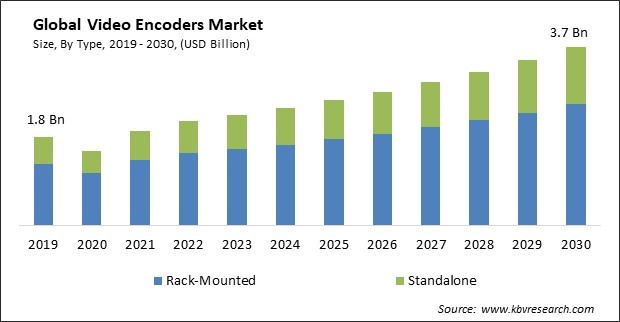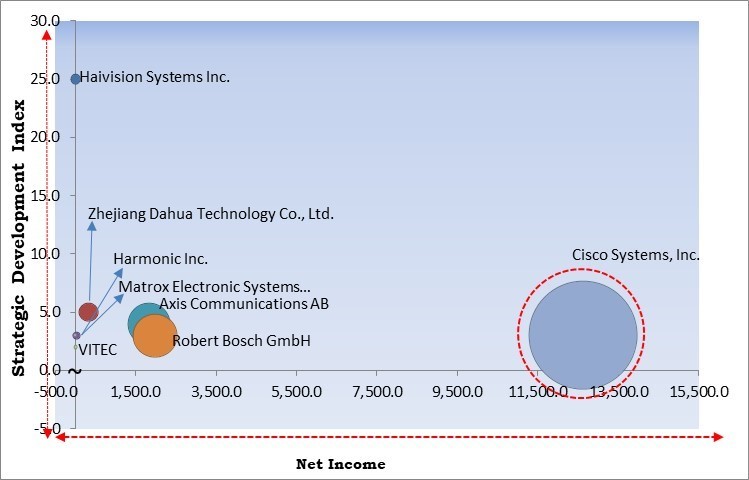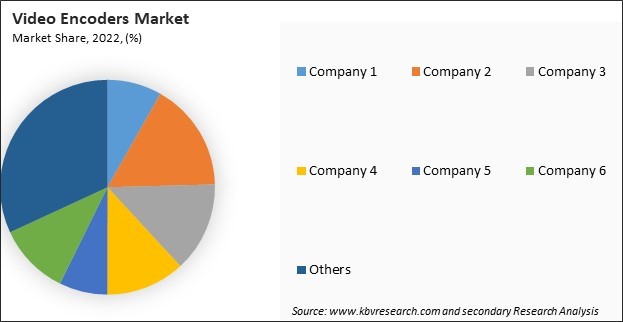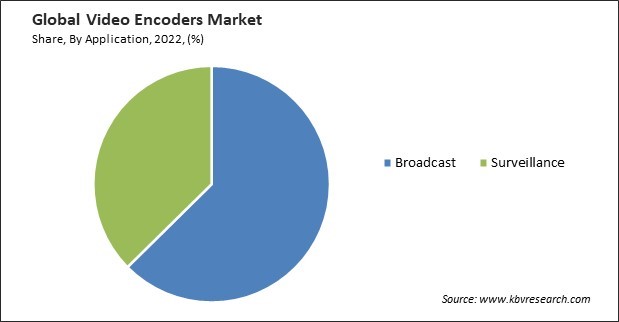The Global Video Encoders Market size is expected to reach $3.7 billion by 2030, rising at a market growth of 7.1% CAGR during the forecast period. In the year 2022, the market attained a volume of 3,812.5 thousand Units experiencing a growth of 6.9% (2019-2022).
Video surveillance systems with facial recognition capabilities find applications in security, law enforcement, and public spaces. This enables security personnel to respond promptly to potential threats or incidents. Therefore, Surveillance segment generated $808.1 million revenue in the market in 2022. Video analytics enables the analysis of behavioral patterns within video footage. Intelligent video analytics systems can generate automated alerts and notifications based on predefined rules or anomalies. This is crucial for securing critical infrastructure, facilities, and sensitive zones. Due to the above aspects the market growth is expected to boost in the coming years.

The major strategies followed by the market participants are Product Launches as the key developmental strategy to keep pace with the changing demands of end users. For instance, In November, 2023, Matrox Electronic Systems Ltd. rolled out Matrox Maevex 7100 Series of single-channel 4K60 AVC/HEVC encoders. The launched product would be available for low-latency, high-quality, low-bitrate encoding of single high-resolution HDMI sources for audio and video streaming, contribution, and collaboration. Moreover, In April, 2020, Bosch announced the launch of INTEOX, a camera platform developed for modernizing the safety and security industry. This is an open platform of its kind and provides unlimited freedom for customization and innovation to system integrators, users, and application developers.
Based on the Analysis presented in the KBV Cardinal matrix; Cisco Systems, Inc. is the major forerunner in the Market. In October, 2023, Cisco Systems, Inc. launched Webex AI Assistant, which used real-time communications for audio and video to solve everyday challenges. The launched product would have new capabilities that would bolster productivity and accuracy for customers. Companies such as Haivision Systems Inc., Zhejiang Dahua Technology Co., Ltd., and Axis Communications AB are some of the key innovators in the Market.

High-resolution video is crucial for accurate facial recognition and identification. In applications where identifying individuals is essential, such as airports, border control, or high-security facilities, the adoption of 4K cameras supports more reliable and precise facial recognition algorithms. The adoption of high-resolution video is closely linked to the integration of advanced analytics in video surveillance systems. Analytics, such as behavioral analysis and anomaly detection, benefit from the rich visual data provided by high-resolution cameras, enhancing the overall intelligence of surveillance solutions. Thus, the increasing adoption of 4K and high-resolution video profoundly impacts the market.
Corporate events, conferences, and gatherings utilize video for event security and management. Video surveillance systems provide real-time monitoring, incident response, and documentation of events, ensuring a secure and organized environment. They support corporate crisis management and emergency response efforts. Real-time video feeds and recorded footage aid in assessing situations, coordinating responses, and ensuring the safety of employees and assets during emergencies. The convergence of security and communication functionalities reflects a growing trend in leveraging video solutions for comprehensive corporate environments, leading to the continued evolution and expansion of the market.
Organizations often need to store video data for extended periods, especially in applications such as law enforcement, transportation, or critical infrastructure monitoring. Planning for long-term storage and ensuring the integrity of archived video content pose additional challenges. Adopting hybrid and cloud storage solutions introduces new data transfer, security, and compliance challenges. Providing seamless integration with video encoders and addressing data ownership and privacy concerns in cloud environments can be complex. Due to the above factors, market growth will be hampered in the coming years.

The leading players in the market are competing with diverse innovative offerings to remain competitive in the market. The above illustration shows the percentage of revenue shared by some of the leading companies in the market. The leading players of the market are adopting various strategies in order to cater demand coming from the different industries. The key developmental strategies in the market are Product Launches and Product Expansions.
Based on type, the market is fragmented into rack-mounted and standalone. In 2022, the rack-mounted segment witnessed the largest revenue share in the market. Rack-mounted video encoders are designed to fit into standard rack units (RU) commonly used in server rooms, data centers, broadcasting facilities, and other professional environments. Common rack sizes include 1U, 2U, or 3U, with 1U being the most compact and space-efficient. Rack-mounted video encoders have network interfaces for seamless integration into IP-based networks. This allows the transmission of encoded video over local area networks (LANs) or wide area networks (WANs).
On the basis of application, the market is segmented into surveillance and broadcast. The surveillance segment recorded a remarkable revenue share in the market in 2022. Surveillance, facilitated by video encoders, significantly improves security by continuously monitoring physical spaces. This proactive approach acts as a deterrent to potential threats, and in the event of an incident, surveillance footage serves as valuable evidence for investigation and resolution. Integrating surveillance applications with video encoders provides a comprehensive solution for organizations seeking to enhance security, optimize operational efficiency, and leverage advanced technologies for monitoring and response. These benefits collectively create safer environments, reduce risks, and improve overall organizational resilience.

Under surveillance type, the market is further divided into retail, transportation, commercial, military & defense, institutional, and other. In 2022, the retail segment held the highest revenue share in the market. Many retailers have legacy analog surveillance systems in place. Video encoders enable the seamless integration of these analog cameras into modern IP-based surveillance networks. Retail surveillance using video encoders enhances the safety of both customers and staff. Surveying areas such as parking lots, entrances, and common spaces helps identify and address potential security issues in real time, contributing to a safer shopping environment.
By number of channel, the market is categorised into 1 channel, 2 channel, 4 channel, 8 channel, 16 channel, and others. In 2022, the 1 channel segment generated the highest revenue share in the market. A 1-channel video encoder is designed to handle video signals from a single source. This can be an analog camera, digital camera, or any other video device with compatible output. Due to its single-channel capacity, a 1-channel video encoder is often compact and portable. This makes it suitable for various deployment scenarios where space considerations are essential. The interfaces of 1-channel video encoders are typically user-friendly, making them accessible to users with varying technical expertise. Web-based interfaces or dedicated software applications may be provided for configuration and monitoring.
| Report Attribute | Details |
|---|---|
| Market size value in 2022 | USD 2.2 Billion |
| Market size forecast in 2030 | USD 3.7 Billion |
| Base Year | 2022 |
| Historical Period | 2019 to 2021 |
| Forecast Period | 2023 to 2030 |
| Revenue Growth Rate | CAGR of 7.1% from 2023 to 2030 |
| Number of Pages | 462 |
| Number of Tables | 953 |
| Quantitative Data | Volume in Thousand Units, Revenue in USD Billion, and CAGR from 2019 to 2030 |
| Report coverage | Market Trends, Revenue Estimation and Forecast, Segmentation Analysis, Regional and Country Breakdown, Competitive Landscape, Market Share Analysis, Porter’s 5 Forces Analysis, Company Profiling, Companies Strategic Developments, SWOT Analysis, Winning Imperatives |
| Segments covered | Type, Number of Channel, Application, Region |
| Country scope |
|
| Companies Included | Harmonic Inc., Axis Communications AB (Canon, Inc.), Haivision Systems Inc., Zhejiang Dahua Technology Co., Ltd., Cisco Systems Inc., Robert Bosch GmbH, Matrox Electronic Systems Ltd., CommScope Holding Company, Inc., Delta Digital Video (Delta Information Systems, Inc.) and VITEC |
| Growth Drivers |
|
| Restraints |
|
Region-wise, the market is analysed across North America, Europe, Asia Pacific, and LAMEA. The Asia Pacific region recorded a remarkable revenue share in the market in 2022. Live streaming and other broadcasting services have been bolstered by the rising prominence of social networking sites, which has increased the demand for video encoders in the Asia-Pacific region. The expansion of public infrastructure, an increase in terrorist activities, crime rates, and data burglaries, as well as remote monitoring, have all contributed to the surge in demand for surveillance cameras in the Asia-Pacific region. In the coming years, the increasing prevalence of video surveillance cameras is anticipated to propel the demand for and acceptance of video encoders in several Asia-Pacific nations.
Free Valuable Insights: Global Video Encoders Market size to reach USD 3.7 Billion by 2030
The market research report covers the analysis of key stake holders of the market. Key companies profiled in the report include Harmonic Inc., Axis Communications AB (Canon, Inc.), Haivision Systems Inc., Zhejiang Dahua Technology Co., Ltd., Cisco Systems Inc., Robert Bosch GmbH, Matrox Electronic Systems Ltd., CommScope Holding Company, Inc., Delta Digital Video (Delta Information Systems, Inc.) and VITEC.
By Type (Volume, Thousand Units, USD Billion, 2019-2030)
By Application (Volume, Thousand Units, USD Billion, 2019-2030)
By Number of Channel (Volume, Thousand Units, USD Billion, 2019-2030)
By Geography (Volume, Thousand Units, USD Billion, 2019-2030)
This Market size is expected to reach $3.7 billion by 2030.
Increasing adoption of 4K and high-resolution video are driving the Market in coming years, however, Data storage and retrieval challenges restraints the growth of the Market.
Harmonic Inc., Axis Communications AB (Canon, Inc.), Haivision Systems Inc., Zhejiang Dahua Technology Co., Ltd., Cisco Systems Inc., Robert Bosch GmbH, Matrox Electronic Systems Ltd., CommScope Holding Company, Inc., Delta Digital Video (Delta Information Systems, Inc.) and VITEC.
In the year 2022, the market attained a volume of 3,812.5 thousand Units experiencing a growth of 6.9% (2019-2022).
The Broadcast segment is registering maximum revenue in the Market by Application in 2022; thereby, achieving a market value of $2.2 billion by 2030.
The North America region dominated the Market by Region in 2022, and would continue to be a dominant market till 2030; thereby, achieving a market value of $1.2 billion by 2030.
Our team of dedicated experts can provide you with attractive expansion opportunities for your business.

